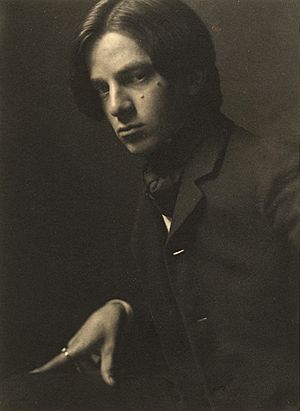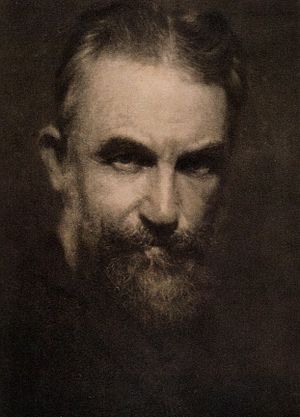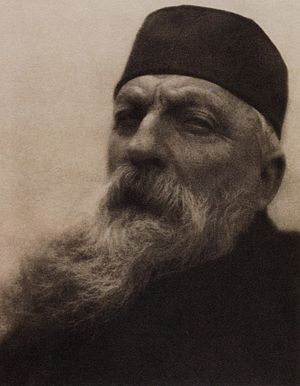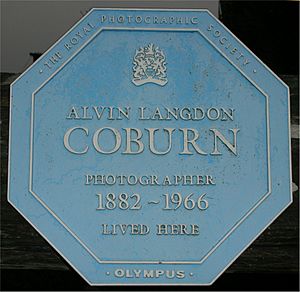Alvin Langdon Coburn facts for kids
Quick facts for kids
Alvin Langdon Coburn
|
|
|---|---|

Self-portrait, 1905
|
|
| Born | June 11, 1882 Boston, Massachusetts, US
|
| Died | November 23, 1966 (aged 84) Rhos-on-Sea, Colwyn Bay, Wales
|
| Known for | Photography |
Alvin Langdon Coburn (born June 11, 1882 – died November 23, 1966) was an important photographer from the early 1900s. He helped shape a style of photography called pictorialism in America. Coburn was one of the first photographers to take pictures from high places. He also created some of the very first completely abstract photographs.
Contents
Alvin Coburn's Life Story
Early Years (1882–1899)
Alvin Coburn was born in Boston, Massachusetts, on June 11, 1882. His family was middle-class. When Alvin was seven, his father passed away. His mother, Fannie, raised him alone and was a big influence on his life.
In 1890, when he was eight, his uncles gave him a Kodak camera. He loved it right away. In just a few years, he became very good at taking pictures and developing them.
When he was 16, in 1898, he met his cousin F. Holland Day. Day was already a famous photographer. He saw Alvin's talent and encouraged him to become a professional photographer.
In late 1899, Alvin and his mother moved to London. His cousin Day had been asked to show photos from American artists there. Day brought over a hundred photos, including nine by 17-year-old Alvin. This was a huge first step for Coburn's career.
Becoming Famous (1900–1905)
Alvin's photos in London caught the eye of Frederick H. Evans, another important photographer. Evans was a founder of the Linked Ring, a group of top artistic photographers. In 1900, Coburn was invited to show his work with them. This made him one of the most respected photographers of his time.
In 1901, Coburn lived in Paris for a few months. He studied with photographers Edward Steichen and Robert Demachy. Afterward, he and his mother traveled through France, Switzerland, and Germany.
They returned to America in 1902. Coburn then studied with famous photographer Gertrude Käsebier in New York. He opened his own photography studio. He also spent time studying art in Massachusetts. His mother always tried to promote his work.
In 1903, Coburn became a member of The Linked Ring. He was one of the youngest members and one of only a few Americans. In May, he had his first solo art show in New York. In July, one of his photos was published in Camera Work magazine.
In 1904, Coburn went back to London. He was hired to photograph famous British artists and writers. These included G. K. Chesterton and H. G. Wells. He also visited Scotland to study the work of early photographers. Six more of his photos appeared in Camera Work. In 1905, he photographed American artist Leon Dabo.
Coburn stayed in London through 1905 and 1906. He took portraits and landscape photos. He photographed Henry James for a magazine. He also went back to Scotland for a photo series inspired by a book about Edinburgh.


New Ideas in Photography (1906–1912)
The years 1906 and 1907 were very important for Coburn. In 1906, he had solo shows in London and Liverpool. Five more of his photos were published in Camera Work. He also began studying how to print photos using a special method called photogravure. During this time, he took a famous picture of writer George Bernard Shaw posing like Rodin's The Thinker statue.
He traveled around the Mediterranean Sea in the summer. In the fall, he visited Paris, Rome, and Venice. While in Paris, he learned how to make color photographs called Autochromes from Steichen.
By 1907, Coburn was very successful. George Bernard Shaw even called him "the greatest photographer in the world," even though Alvin was only 24. He had a solo show at Stieglitz's famous Little Galleries of the Photo-Secession in New York. He also helped organize a big photo exhibition in London.
An art collector asked Coburn to photograph his large collection of Asian art and Whistler prints. Coburn was fascinated by the "exotic" style of Asian art. This new interest started to influence his own photography.
In January 1908, twelve more of Coburn's photos were published in Camera Work. The magazine's editor, Stieglitz, sometimes wrote critical comments. However, this did not harm their friendship.
In the spring, Coburn had another solo show in New York. He wrote to Stieglitz that he was printing mostly in gray now. He visited Dublin that summer and took portraits of writers W. B. Yeats and George Moore. He also traveled to Bavaria and Holland.
Around this time, writer H. G. Wells asked Coburn to work on a special edition of his book, The Door in the Wall and Other Stories. This book, with Coburn's photos, was published a few years later.
In 1909, Stieglitz gave Coburn his second solo exhibition at his gallery, "291". This was a big honor, as only one other photographer had two shows there. Back in London, Coburn bought a new home with a large studio. He used his printing skills to publish a book of his own photos called London.
Coburn returned to America in 1910. He showed 26 prints in Buffalo, New York. For the next year, he traveled widely in the U.S. He photographed the Grand Canyon in Arizona and Yosemite National Park in California. He came back to New York in 1912. There, he took new photos for his book New York. During this time, he took famous photos from high places, like his well-known image The Octopus.
While in New York, he married Edith Wightman Clement on October 11, 1912. In November, Coburn and his wife returned to England. He never went back to the United States after that.
New Directions (1913–1923)
Coburn continued to gain fame by publishing his most famous book, Men of Mark, in 1913. This book had 33 photo prints of important European and American writers, artists, and leaders. These included Henri Matisse, Henry James, Auguste Rodin, Mark Twain, and Theodore Roosevelt.
In 1915, Coburn organized an exhibition called Old Masters of Photography. It was shown in London and New York. The show included many old photos from Coburn's own collection.
The next year, two important things happened in his life. He met George Davison, a photographer who was interested in spiritual ideas. This led Coburn to study mysticism and other spiritual topics. He also met Ezra Pound, who introduced him to a new art movement called Vorticism. This new style interested Coburn. He began to change his photography, exploring his spiritual journey. He took a bold portrait of Pound, showing three overlapping images. Soon after, he created a series of abstract photos. These were some of the first completely non-representational photos ever made.
To make these abstract images, Coburn invented a special tool. It was like a kaleidoscope with three mirrors. When placed over the camera lens, it would reflect and break up the image. Pound called this tool a "Vortoscope" and the photos "Vortographs". Coburn made only about 18 different Vortographs in just one month. Yet, they are still some of the most striking photos from the early 1900s.
In 1917, he had a show of his Vortographs and paintings in London. He had recently started painting in a style called Post-Impressionist. The show got mixed reviews, especially because his paintings were not as strong as his photos. Stieglitz did not like Coburn's new abstract work.
On June 18, 1919, he joined a group called the Freemasons. Coburn became more and more involved with the Freemasons. He also joined another spiritual group and studied more about spiritual ideas. Eventually, he spent most of his life on these studies, and photography became less important to him.
In 1922, Coburn published More Men of Mark. This was a second book of portraits he had taken more than 10 years earlier. It included photos of Pound, Thomas Hardy, and Joseph Conrad.
Focus on Spirituality (1923–1930)
In 1923, Coburn met a man who greatly influenced the rest of his life. This man was a leader of a small religious group called the Universal Order. The group focused on philosophy, religion, and mysticism. Coburn was deeply impressed by this man. His strong interest in spiritual beliefs, especially Freemasonry, became the most important part of his life.
Coburn researched the history of Freemasonry and other spiritual topics. He gave many talks about his findings at Masonic meetings. He traveled widely throughout England and Wales. He was also very interested in the special ceremonies and their meanings.
In 1927, Coburn was honored by a Welsh group of Druids. He took the Welsh name "Maby-y-Trioedd," meaning "Son of the Triads."
In 1928, his mother passed away. She had been a major influence on him. Her death further confirmed his dedication to his new spiritual interests.
Later Life (1931–1966)
By 1930, Coburn had almost no interest left in photography. He decided that his past work was not important anymore. That summer, he destroyed nearly 15,000 glass and film negatives. This was almost all the photos he had ever taken. The same year, he gave his large collection of photos to the Royal Photographic Society.
A year later, he wrote his last letter to Stieglitz. After that, he took only a few new photographs. Even though he was leaving photography, Coburn was elected an Honorary Fellow of the Royal Photographic Society.
After living in England for over 20 years, Coburn officially became a British citizen in 1932.
In 1945, he moved from his house in Harlech, North Wales, to Rhos-on-Sea, Colwyn Bay. He lived there for the rest of his life.
His wife, Edith, died on October 11, 1957. This was their 45th wedding anniversary.
Alvin Coburn passed away at his home in North Wales on November 23, 1966. He was 84 years old.
Gallery
-
George Meredith (1911)
See Also
 In Spanish: Alvin Langdon Coburn para niños
In Spanish: Alvin Langdon Coburn para niños






